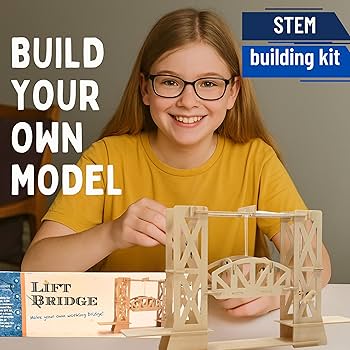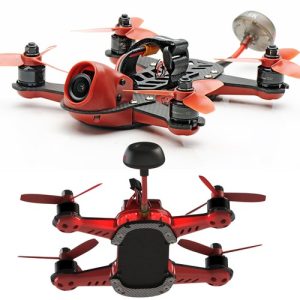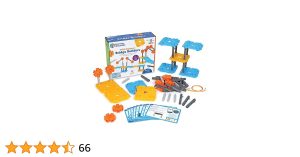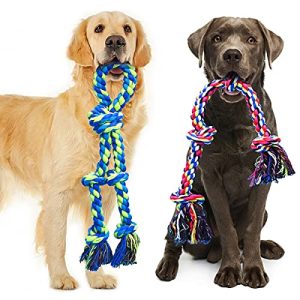Are you looking for a fun way to boost your child’s creativity and problem-solving skills? Bridge building toy kits STEM can be exactly what you need.
These kits turn learning into play by letting you build real-life bridges using simple parts. Imagine the excitement of watching your own bridge stand strong, all while understanding the science behind it. Keep reading to discover how these kits can make STEM learning hands-on, exciting, and something you and your child will love.

Credit: www.amazon.ca
Benefits Of Bridge Building Kits
Bridge building toy kits help kids learn and have fun at the same time. They are great tools to teach science, technology, engineering, and math (STEM) skills.
These kits encourage hands-on learning. Kids can see how bridges hold weight and how different shapes affect strength.
Enhancing Stem Skills
Bridge kits let kids practice STEM skills in a practical way. They learn about physics, engineering, and math by building structures.
Children explore concepts like balance, force, and tension. This helps them understand how real bridges work.
- Learn basic engineering principles
- Practice measuring and calculating
- Understand forces like tension and compression
Boosting Creativity
Bridge building kits allow kids to design their own models. They use creativity to choose shapes and materials for their bridges.
Kids try different ideas and see what works best. This process encourages original thinking and innovation.
- Create unique bridge designs
- Experiment with new building styles
- Express imagination through structures
Improving Problem-solving Abilities
Building bridges is a challenge that needs planning. Kids learn how to solve problems step by step.
They figure out how to fix weak points and make their bridges stronger. This skill helps in many real-life situations.
- Identify design problems
- Test solutions and make changes
- Think critically about structure stability
Popular Types Of Bridge Kits
Bridge building toy kits help kids learn about engineering and design. They come in many materials and styles.
This guide covers popular types of bridge kits for fun and education.
Wooden Bridge Kits
Wooden bridge kits use natural wood pieces for building models. They teach basic construction skills.
These kits often include planks, beams, and connectors to create strong bridges.
- Easy to handle and assemble
- Good for hands-on learning
- Durable and eco-friendly
- Helps understand real bridge structures
Plastic Construction Sets
Plastic construction sets have colorful pieces that snap or screw together. They offer many building options.
These kits often include rods, panels, and joints to build different bridge types.
- Lightweight and easy to use
- Encourages creativity
- Can build complex designs
- Safe for younger kids
Magnetic Bridge Kits
Magnetic bridge kits use magnetic pieces to connect parts quickly. They make building fun and flexible.
These kits often include magnetic bars and steel balls or plates to create strong bridges.
- Easy to assemble and change
- Supports learning about magnetism
- Builds both simple and complex bridges
- Great for teamwork and experiments
Choosing The Right Kit
Bridge building toy kits help kids learn about engineering and design. Picking the right kit can make the experience fun and educational.
Consider age, skill, and safety before buying a kit. These factors ensure the kit suits the child’s needs and abilities.
Age Appropriateness
Choose a kit that matches the child’s age. Younger kids need simpler kits with bigger pieces. Older kids can handle more complex sets with small parts.
- For ages 4-6: Large pieces, easy to snap together
- For ages 7-10: Moderate complexity, some instructions
- For ages 11 and up: Advanced kits with detailed plans
Skill Level Considerations
Skill level affects how much help a child will need. Start with simple kits if they are beginners. Choose challenging kits for experienced builders.
| Skill Level | Kit Features | Recommended Age |
| Beginner | Basic shapes, simple instructions | 4-7 years |
| Intermediate | More parts, building challenges | 8-12 years |
| Advanced | Complex designs, detailed instructions | 12+ years |
Material And Safety Factors
Materials must be safe and durable. Look for non-toxic plastics or wood. Avoid kits with sharp edges or loose small parts.
- Check if materials are BPA-free or eco-friendly
- Look for certifications like ASTM or EN71
- Ensure parts are large enough to prevent choking
- Supervise young children during play
Tips For Engaging Learning
Bridge building toy kits help kids learn about science and engineering. They make learning fun and hands-on. Using these kits can boost curiosity and problem-solving skills.
To get the most from these kits, try different ways to keep kids involved. Here are some tips to make learning exciting and effective.
Incorporating Challenges
Adding challenges makes the activity more interesting. It pushes kids to think and try new ideas. Challenges can be simple or complex based on age and skill.
- Set a time limit to build the strongest bridge
- Ask them to use only certain materials
- Challenge them to hold more weight with less support
- Encourage redesigns to improve their first model
Encouraging Teamwork
Working in groups helps kids share ideas and solve problems together. Teamwork teaches communication and cooperation skills. It also makes learning more fun.
| Team Role | Responsibilities |
|---|---|
| Designer | Draws bridge plans and sketches |
| Builder | Assembles pieces according to the plan |
| Tester | Checks if the bridge holds weight |
| Recorder | Keeps notes on changes and results |
Linking To Real-world Engineering
Connecting the activity to real bridges helps kids see why learning matters. It shows how engineers solve real problems and build safe structures.
- Discuss famous bridges and their designs
- Explain materials used in real construction
- Show videos or pictures of bridges in use
- Talk about how weather affects bridge safety
Creative Bridge Design Ideas
Building bridges with toy kits helps children learn science and engineering. It also sparks creativity and problem-solving skills.
Different types of bridges have unique shapes and structures. Exploring these designs can make your projects more fun and educational.
Suspension Bridges
Suspension bridges hang the road deck from cables. These cables stretch between tall towers and hold the weight.
Try making long, curved cables and tall towers with your kit. This design shows how real bridges carry heavy loads.
- Create strong towers with blocks or rods
- Use string or flexible rods for cables
- Make the deck hang below the cables
- Test how much weight your bridge holds
Arch Bridges
Arch bridges use a curved shape to carry weight. The curve pushes forces outward to the supports on each side.
Build arches with curved pieces or arrange straight parts in a bow shape. This helps the bridge stay strong and stable.
- Use curved blocks or connect straight pieces in an arch
- Place sturdy supports at each end of the arch
- Keep the road deck on top of the arch
- Try different arch heights and widths
Truss Bridges
Truss bridges use triangles in their design. Triangles make the bridge very strong and help spread the load.
Build many small triangles using rods or sticks. Connect them tightly to create a strong framework for the bridge deck.
- Make triangles with straight pieces
- Connect triangles side by side for length
- Keep the deck supported on top or inside the truss
- Test stability by adding small weights

Credit: www.amazon.ca
Stem Learning Outcomes
Bridge building toy kits are fun and educational. They help kids learn important STEM skills. These kits teach physics, math, and engineering.
By building bridges, children see real-world applications of what they learn in school. Let’s explore the concepts involved.
Physics Concepts In Action
Physics concepts come to life with bridge building kits. Kids learn about forces, balance, and tension. They see how these ideas work in real structures.
- Gravity affects how bridges hold weight.
- Understanding tension helps in building strong bridges.
- Balance is key to keeping structures stable.
Mathematical Applications
Mathematics plays a big role in building bridges. Kids use measurements and calculations to make sure everything fits well.
| Concept | Application |
| Measurement | Ensures pieces fit together |
| Geometry | Shapes create strong structures |
| Counting | Tracks the number of pieces |
Engineering Principles
Engineering is about solving problems. Bridge kits let kids test and improve their designs. They learn to think like engineers.
Where To Buy Quality Kits
Bridge building toy kits are fun and educational. They help kids learn about engineering and design.
Finding the right kit can be easy if you know where to look. Here are some places to find quality kits.
Online Retailers
Online shopping offers convenience and variety. Many sites have a wide range of bridge building kits.
- Amazon: A large selection of kits with customer reviews.
- eBay: Offers both new and used options.
- Etsy: Unique and handmade kits by small sellers.
Educational Stores
These stores focus on learning products. They often have kits that teach STEM skills.
Check local educational supply stores for kits. They often have knowledgeable staff to help choose the right product.
Diy Kit Options
Do-it-yourself kits can be a fun project. They offer a hands-on experience for kids and adults.
| Store | Kit Type |
| Craft Stores | Basic materials and instructions |
| Hardware Stores | Tools and raw materials |
| Online Tutorials | Guides and videos |

Credit: www.amazon.ca
Frequently Asked Questions
What Are Bridge Building Toy Kits Stem Benefits?
Bridge building toy kits develop critical STEM skills like engineering, math, and problem-solving. They enhance creativity and hands-on learning. These kits encourage teamwork and logical thinking. Kids gain practical knowledge of physics and structural design. Overall, they provide a fun and educational experience in STEM fields.
How Do Stem Kits Improve Engineering Skills?
STEM kits offer practical challenges that mimic real engineering problems. They improve spatial reasoning and design thinking. Users learn to build stable structures using scientific principles. The hands-on process reinforces theoretical concepts. This fosters a deeper understanding of engineering fundamentals in a fun way.
Which Age Group Suits Bridge Building Kits Best?
Most bridge building STEM kits suit children aged 8 to 14 years. This range matches their cognitive and motor skill development. Younger kids may find complex kits challenging. Older kids and teens benefit from advanced designs and problem-solving tasks. Always check manufacturer age recommendations for safety.
Can Bridge Building Kits Be Used In Classrooms?
Yes, these kits are excellent for classroom STEM education. They promote interactive and collaborative learning. Teachers can integrate them into lessons on physics, math, and engineering. They help illustrate theoretical concepts practically. This increases student engagement and comprehension in STEM subjects.
Conclusion
Bridge building toy kits make learning fun and hands-on. Kids explore science, technology, engineering, and math easily. These kits help develop creativity and problem-solving skills. Playing with them encourages teamwork and patience too. Each project shows how bridges stand strong and safe.
Using simple parts, children build real structures step by step. These toys inspire curiosity about the world around us. A great way to support STEM learning at home or school. Building bridges has never been this enjoyable and educational. Try one and watch young minds grow and learn.





